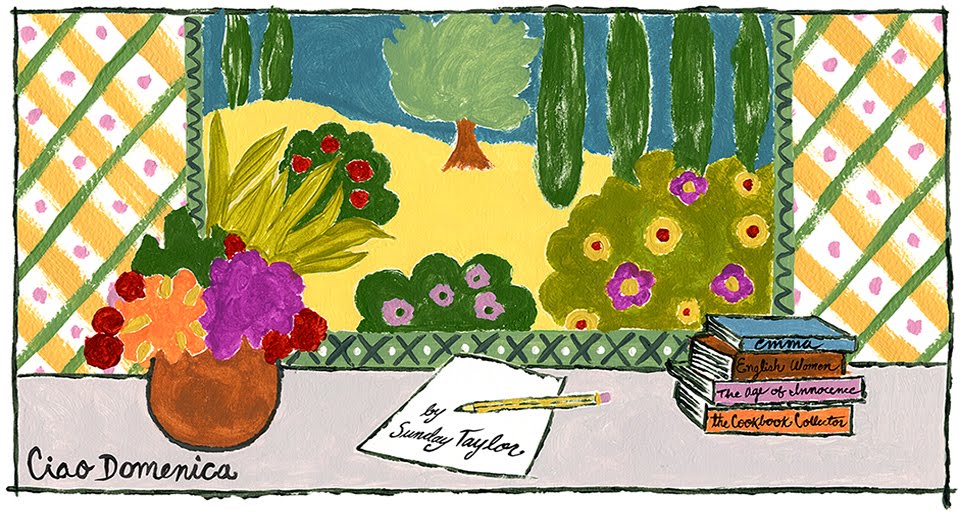Lady Hamilton as 'Nature' by George Romney
The Frick Collection in New York city is an oasis of beauty and peace for everyone who visits. Housed in the elegant Gilded Age mansion that once belonged to Henry Clay Frick, this small museum offers a lovely setting to view art as well as a comfortable place to feel in touch with history. Every time I am in New York I visit the Frick and am always happy to return. There are certain paintings that I love and check in with during my visit. In addition to its fabulous permanent collection, the Frick also has fascinating exhibitions.
One of my favorite paintings is the portrait (above) of Emma Hamilton by George Romney. I have been interested in it since I read "The Volcano Lover" by Susan Sontag. That book told the story of Emma Hamilton, Sir William Hamilton and Admiral Nelson. Emma was the muse of George Romney. She started out as the daughter of a blacksmith and went on to marry Sir William Hamilton, the British ambassador to Naples. She had a scandalous affair with the great naval hero Admiral Nelson. She was an 18th-century superstar and this painting shows her in the early days as a young, unaffected teenager at the outset of her career.
When I went to the Frick's website, I learned some interesting information about this painting. Emma was 17 years old when she posed for this portrait commissioned by her lover the Hon. Charles Greville. She was a beautiful young woman and Greville hoped to make some money by selling Romney's paintings of her. However he eventually grew tired of Emma and asked his 62-year old uncle Sir William Hamilton to take her off his hands. Hamilton did more that that; he married her. He took her to Naples where she became a sensation due to her beauty and talent for assuming "attitudes," romantic posturing achieved with shawls and classical draperies in which she became a living work of art. In Naples Emma met Admiral Horatio Lord Nelson with whom she had a notorious love affair which continued until his death in 1805. Though she inherited money from both her husband and her lover, her extravagance led her into debt and she died in poverty.
"St. Francis in the Desert" by Bellini
I also loved the exhibition a few years ago of Bellini's "St. Francis in the Desert." The exhibition was about the research that the Frick undertook in conjunction with the Metropolitan Museum into some the great mysteries surrounding this painting and its meaning. They used infrared technology to create the first complete image of the underdrawing that guided the artist's hand. I was impressed by the level of study and analysis that went into the process. The exhibition reminded me that museums are not just static institutions displaying works of art but vibrant institutions of learning where continual study and research keep the art alive, meaningful and relevant. It was inspiring to learn what goes on behind the scenes of our greatest museums.
Thomas Cromwell by Hans Holbein
Ever since I read Hilary Mantel's books on Thomas Cromwell this painting by Hans Holbein has taken on new life for me. I now check in with it each time I visit the Frick. It sits across the fireplace from a portrait of Cromwell's mortal enemy Thomas More. In fact, they hang face to face. We know from Mantel's book that Cromwell was a ruthless man. This painting shows his intensity in his face as well as his body language. He looks like a successful man, always on the alert and ready for anything. He is prepared to do the business of the king.
"Winter" by Francois Boucher
And for sheer delight and beauty these panels representing the "Four Seasons" by Francois Boucher always knock me out. They are simply stunning. "Winter" is my favorite. From the website I learned that Boucher made the panels for one of the homes of his major patron Madame de Pompadour and that they were probably intended for over door decorations. The subject of each painting is love. "Winter" depicts a snowy scene with a young man dressed in a Russian costume pushing the heroine in an elaborate Rococo sleigh. She wears a billowing fur trimmed gown and a little fur necklace, though her chest is exposed to the elements. She looks out at the viewer with a coy expression on her face. According to the information on the website, this combination of luxury and seduction is typical of Boucher.
On Sunday the NY Times had a fabulous article on an outreach program at the Frick that really excited me. Students at the Ghetto Film School in the South Bronx are participating in a yearlong collaboration with the Frick. The program draws on the museum's collection to inspire the storytelling abilities of young people while simultaneously building fine arts into the school's curriculum. The students go to the museum on Mondays, when it is closed, for discussions with its curator on art by Rembrandt, Vermeer, Fragonard and others. The students then write scripts inspired by the art or the setting. They choose one script to make into a film and do the filming at the Frick. What a dynamic way to get young people involved in the art world and bring art to the schools. Go here to read more. You'll be surprised at the paintings that inspired the winning script. Wouldn't it be wonderful if more museums did this kind of thing?





